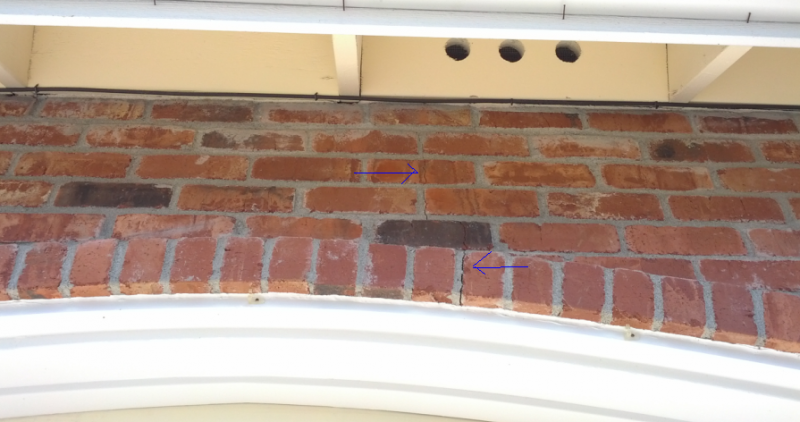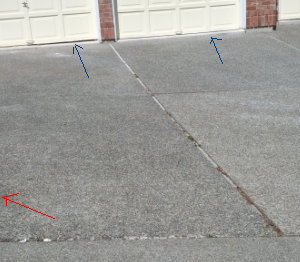House on a slope and with some cracks/settle down. Normal or not?
The house is 20 years old. One side of the house on higher level, another side of house is on lower level. All the cracks and the settledown are found on the side of lower level.
1:a crack above the right garage door ; the drive way with very obvious settledown,the settledown in the right place is most serious. There is a city water box on the left driveway.




2: a vertical crack above the fireplace (only on the brick,not go up to the wall above the brick) in the first floor

3: a horizontal crack on the ceiling of the second floor

4:a vertical old crack above a door of the second floor

All the cracks and settle down places are all in the side of the house in lower level of the slope. Wonder whether there any connection with the slope? Should the problems be paid attention to?
Thanks


























Replies
Thanks for the reply.
I guess I can relax about them now. :)
You do want to watch for any signs of substantial settling -- large cracks, pavement pulling away from the foundation, etc. And make sure that serious erosion doesn't take hold on the downhill side.
Thanks, but
how can I make sure that serious erosion doesn't take hold on the downhill.
What kind of crack is "large" crack? what is pavement pulling away from the foundation?
Pavement pulling away from the foundation would be just that -- the pavement has moved an inch or two away from the foundation, leaving a gap that wide.
"Large crack" depends on where it is. In your pictures the only thing I see that comes close is the crack beside the garage door, where the garage slab has apparently settled. But that one is probably self-limiting. Otherwise, a crack in the brickwork that was wider than about 1/4" might be worrisome, depending on where it was exactly.
Most houses settle a bit over time - if it only settled 1/2" you'd be lucky. If a house settles 2" but it's consistent everywhere there would be no cracks, while a house that settles 1/2" to 1" unevenly will show cracks somewhere.
Honestly when I check a foundation I don't pay as much attention to cracks as I do the level of the foundation. If one side of your house is resting about where it was built and half has settled a couple inches I'd be concerned if anything has cracked or not since that's often a condition that continues to get worse over time unless you're lucky and it's simply do to fill dirt that wasn't compacted as well as it could be. Worst case is the hill side is slowly going downhill and in 20 more years the cracks will be more substantial and 20 more years you're looking at a total foundation replacement.
On the surface I'd guess your house is fine, but without running a laser or water level around the foundation it's hard to tell what it has or hasn't done these past few decades. :)
How to run a water level test around the foundation?
Thanks for your information.
I have a water level measuring tool (it like a long ruler, with length about 2- 3 meters). How can I run water level measure "around' the foundation using it?
I have put the the water level measuring tool on the ground of first floor and the second floor. There is no big problem found. Should I put the tool in the crawspace? (I just worry that I cannot find a enough space to put the tool in the crawspace).
Do you think that my house has experienced"unevenly" settled down from the above pictures? The inspector of my only mentioned the driveway in front of the house need to be added something into (like concrete) to make it go up to normal level.
The water level I'm referring to is 100' of stiff tubing filled with water. One end is held stationary and the other end is taken around the house and the water line is marked on the house a dozen or so places creating a uniform refference line. The same can be done with a rotary lazer level. Simply measuring down from these refference marks to the top of the foundation will show what the house is doing.
A normal level as you've described won't tell you anything useful.
The cracks in your house look pretty normal on the surface, but like I said it's hard to tell without actually measuring the house. If it were my house I wouldn't worry about it.
It's been a few months since I've been here and I just got your pm and thought I'd just post my reply here.
When I mentioned if it were my house I wouldn't worry about it what I ment is the house is what it is and whatever the condition of the foundation is isn't going to change without a lot of work so I'd just live with it and see how the foundation holds up over time. If it gets worse I'd start planning a strategy to fix it, or help it hold up as long as possible over the long term.
Most houses have some irregular settling and it doesn't affect them adversely over the long term.
Thanks for reply. I will keep eyes on the change...
Hope there will be no big issue to impact my house's selling if I have to sell it in the future...
The typical house buyer (unfortunately) has no real appreciation for what is or isn't a "fatal" flaw. The result is they may latch onto some minor detail of your house and consider that a deal-killer while ignoring some other sign (in a different house) that the house is virtually doomed.
About all you can do is worry about "curb appeal" -- fix (or conceal) those things that are most obvious (eg, caulk the crack under the garage door frame).
But you only need to do this if you're planning to sell the house (or if you want to do it just for appearance's sake).
You really understand the buyer's mind....
One of my neighbor is fixing the problem of their house now. I guess they will sell their house soon.
Do understand that potential buyers will be comparing your house to others of a similar age and price range. You don't have to outrun the bear, you just have to outrun the other guy the bear is chasing.
:)
Maintenance required
To avoid further destruction of your building you should perform some maintenance work. contact us mlsroofing
2 things MLS
One- No Free Ads here-contact the FHB ad dept. Otherwise it's just spam.
Two- If you think slapping on black roof goop is maintainance, then you have a lot to learn.
There's no way anyone in their right mind would be calling MLSRoofing.
thanks.
That's 3 things.
What area of the country is this in? What is the predominate soil type. I live in the midwest where our soil (if you call it that) is clay) Clay expands and contracts according to the moisture in it. The interection of my drive slab and garage floor can vary from nearly flat to a two inch drop as you show over the course of a year.
Thanks. I will pay attention to the information you sent...
I live in northwest of USA and not sure what kind of soil is here. I think I will ask some one else who live here for a long time.
But there is a finding that most of my neighbors don't have the same problem in their garage /driveway. Only another neighbor has the similar problem. so I guess the problem may be not produced by soil type...
The subsidence has almost certainly occurred because the fill put under the driveway and garage slab was not properly compacted. Being on a hill likely required more fill, and few contractors properly compact such fill since it's cheaper to buy the BI a drink.
If you really want it fixed, you can get it "mud jacked" for a fairly reasonable price (far cheaper than replacing the concrete, and with relatively little disturbance).
It seems like not a problem of foundation from what you said.
Thanks. I guess "not properly compact" is not a "problem of foudation" and "Not properly comapct" is more easy to solve....
None of the pictures you posted suggest significant settling of the foundation itself. Rather the driveway and garage floor slabs have subsided relative to the foundation. This is not a serious problem.